In a world increasingly focused on sustainability, the materials we use matter more than ever. Certified sustainable wood is one such material, offering a way to enjoy wood products without harming the environment. But what exactly does “certified sustainable wood” mean, and why should you care?
Certified sustainable wood comes from forests managed in a way that ensures long-term ecological balance. This means the wood is harvested in a way that maintains biodiversity, supports the local environment, and doesn’t lead to deforestation or habitat destruction.
Several organizations certify sustainable wood, each ensuring the wood is sourced under strict environmental, social, and economic standards. The most notable are:
- Forest Stewardship Council (FSC). FSC certification guarantees that wood products come from responsibly managed forests that provide environmental, social, and economic benefits.
- Program for the Endorsement of Forest Certification (PEFC). PEFC certifies sustainable forest management practices across 300 million hectares of forests globally.
- Sustainable Forestry Initiative (SFI). SFI focuses on North American forests and ensures responsible harvesting, protecting wildlife, and supporting local communities.
Why Certified Sustainable Wood Matters
Choosing certified sustainable wood has significant impacts on both the environment and society.
- Sustainably managed forests help reduce deforestation, a significant driver of climate change.
- Fact: The World Resources Institute reports deforestation contributes around 10% of global greenhouse gas emissions.
- Certified wood protects vital ecosystems that house many species. According to the WWF, forests are home to 80% of the world’s terrestrial biodiversity.
- Certified forests often involve fair labor practices and respect indigenous land rights, ensuring long-term economic benefits for forest-dependent communities.
- Sustainable practices ensure that forests can continue to supply wood for generations without depleting the resource.
The Certification Process: How Does Wood Become Certified?
Wood can only be certified as sustainable after going through a rigorous process that includes:
- The forest owners must create a management plan to protect biodiversity, water sources, and long-term forest health.
- Certifying bodies conduct regular audits to maintain standards throughout the supply chain.
- Certified wood must be tracked from the forest to the final product, ensuring that only sustainably sourced wood is labeled as such.
How to Identify Certified Sustainable Wood Products
When purchasing wood or wood products, look for labels from certifying organizations like FSC, PEFC, or SFI. Many brands also make sustainability a core part of their mission, so check product descriptions and company websites for sustainability claims.
Uses for Certified Sustainable Wood
Certified wood is used in a wide range of applications:
- From coffee tables to bookshelves, using sustainable wood helps reduce the environmental impact of furniture production.
- Green building practices often rely on certified wood to minimize the carbon footprint of new homes and buildings.
- Everyday items like paper and packaging can also come from certified sustainable sources.
- Decking, fencing, and garden furniture are popular uses for certified wood that enhance your space while supporting eco-friendly practices.
The Long-Term Impact of Choosing Certified Wood
By choosing certified sustainable wood, you’re contributing to:
- Climate Change Mitigation: Forests act as carbon sinks, absorbing and storing carbon dioxide. Sustainable forestry helps maintain these vital carbon sinks.
- Wildlife Protection: Sustainably managed forests protect habitats for diverse wildlife species.
- Fair Labor and Ethical Practices: Certified wood often comes from forests where workers’ rights are protected and fair wages are paid.
Final Thoughts
Switching to certified sustainable wood is one of the simplest ways to reduce your environmental footprint without sacrificing quality. Every time you buy a piece of furniture, build a deck, or even choose paper products, you can opt for certified sustainable options that ensure the health of forests and communities worldwide.
Next time you shop, look for that FSC, PEFC, or SFI label. You’ll be making a choice that not only benefits you but the planet as well.
Ready to Make a Difference?
Here are a few certified wood products to get you started.
By choosing certified sustainable wood, you’re helping protect our planet for future generations while enjoying high-quality, durable wood products.
References





